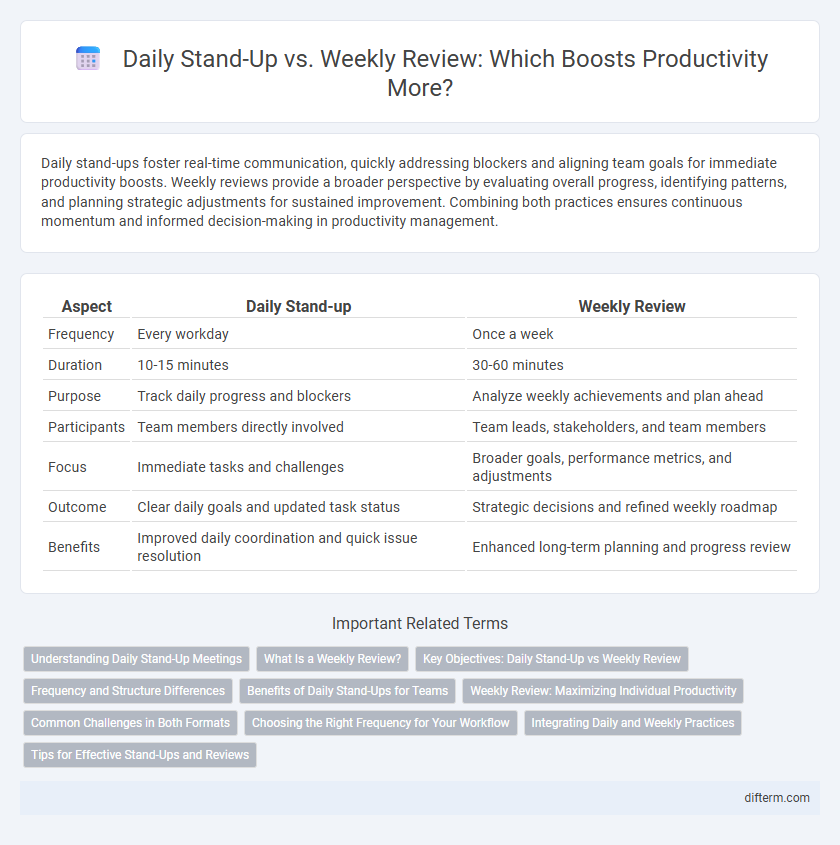Daily stand-ups foster real-time communication, quickly addressing blockers and aligning team goals for immediate productivity boosts. Weekly reviews provide a broader perspective by evaluating overall progress, identifying patterns, and planning strategic adjustments for sustained improvement. Combining both practices ensures continuous momentum and informed decision-making in productivity management.
Table of Comparison
| Aspect | Daily Stand-up | Weekly Review |
|---|---|---|
| Frequency | Every workday | Once a week |
| Duration | 10-15 minutes | 30-60 minutes |
| Purpose | Track daily progress and blockers | Analyze weekly achievements and plan ahead |
| Participants | Team members directly involved | Team leads, stakeholders, and team members |
| Focus | Immediate tasks and challenges | Broader goals, performance metrics, and adjustments |
| Outcome | Clear daily goals and updated task status | Strategic decisions and refined weekly roadmap |
| Benefits | Improved daily coordination and quick issue resolution | Enhanced long-term planning and progress review |
Understanding Daily Stand-Up Meetings
Daily stand-up meetings enhance team productivity by facilitating quick, focused updates that identify immediate roadblocks and prioritize tasks for the day. These brief sessions, usually lasting 15 minutes, promote accountability and ensure alignment on short-term goals, unlike weekly reviews which cover broader progress and strategic adjustments. Emphasizing clear communication and rapid problem-solving during daily stand-ups drives continuous workflow improvement and team cohesion.
What Is a Weekly Review?
A weekly review is a structured productivity practice where individuals assess their past week's tasks, progress, and goals to plan the upcoming week effectively. This routine helps identify priorities, track ongoing projects, and adjust strategies to stay aligned with long-term objectives. Unlike daily stand-ups that focus on immediate, short-term updates, weekly reviews provide a broader perspective on workflow efficiency and goal achievement.
Key Objectives: Daily Stand-Up vs Weekly Review
Daily stand-ups enhance team agility by providing immediate updates on key objectives, facilitating quick adjustments and transparent accountability. Weekly reviews offer a comprehensive assessment of progress toward strategic goals, enabling in-depth reflection and informed planning. Combining both practices ensures continuous alignment and optimized productivity across project timelines.
Frequency and Structure Differences
Daily stand-ups occur every day and are short, typically lasting 15 minutes, with a structured format where team members share progress, plans, and blockers. Weekly reviews happen once a week, involving longer sessions focused on detailed analysis of completed tasks, goal assessments, and strategic adjustments. The differing frequency affects the granularity of updates, with daily stand-ups promoting quick synchronization and weekly reviews enabling comprehensive evaluation and planning.
Benefits of Daily Stand-Ups for Teams
Daily stand-ups enhance team communication by providing quick, focused updates that identify obstacles and align priorities in real time. Regular short meetings boost accountability and maintain momentum, reducing the risk of project delays. Frequent synchronization fosters collaboration, helping teams adapt swiftly to changes and improve overall productivity.
Weekly Review: Maximizing Individual Productivity
Weekly reviews maximize individual productivity by providing a structured opportunity to evaluate progress, set priorities, and adjust goals based on recent achievements and challenges. This reflective practice enhances time management and prevents task overload by ensuring alignment with long-term objectives. Incorporating weekly reviews into a productivity routine fosters continuous improvement and strategic planning beyond the immediate task updates typical of daily stand-ups.
Common Challenges in Both Formats
Daily stand-ups and weekly reviews often face challenges such as time management issues, where meetings either run too long or become rushed, reducing their effectiveness. Participants may struggle with maintaining engagement and relevance, leading to repetitive updates or lack of actionable insights. Both formats require clear objectives and disciplined facilitation to overcome these common pitfalls and drive consistent team productivity.
Choosing the Right Frequency for Your Workflow
Daily stand-ups foster continuous communication and quick issue resolution, ideal for fast-paced projects requiring agile adjustments. Weekly reviews provide comprehensive progress analysis and strategic planning, suited for longer-term goals and less frequent updates. Selecting the right frequency depends on your team's project complexity, collaboration needs, and decision-making pace to maximize productivity and maintain workflow efficiency.
Integrating Daily and Weekly Practices
Combining daily stand-ups with weekly reviews enhances productivity by ensuring continuous alignment and progress tracking through short, focused meetings complemented by comprehensive evaluation sessions. Daily stand-ups facilitate immediate issue resolution and task prioritization, while weekly reviews provide strategic insights and performance assessment for long-term goal adjustment. Integrating these practices fosters a dynamic workflow that balances real-time collaboration with reflective planning.
Tips for Effective Stand-Ups and Reviews
Daily stand-ups boost team alignment through brief, focused updates that prioritize task progress and obstacle identification, while weekly reviews offer comprehensive reflections on achievements and goal adjustments. Maximizing stand-up effectiveness requires strict time limits, clear agendas, and active participation from all members. For weekly reviews, incorporating data-driven performance metrics and collaborative problem-solving enhances decision-making and continuous improvement.
Daily stand-up vs Weekly review Infographic

 difterm.com
difterm.com